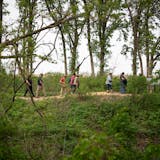Sisi Mitchell pores over tables of data showing the number of homicides, assaults, arrests and community engagements with police in Minneapolis. Her task is to find which precincts have the most positive interactions with police, compared to arrests and crimes.
She's not an analyst at the police department. She's a freshman in an algebra class at South High School.
"Sometimes you think, 'Will I ever use this in real life?' " Mitchell said. "But we tend to do a lot of stuff that you are going to do in real life here."
Stephanie Woldum, Mitchell's teacher, draws students into math through statistics and data that reveal disparities and other inequities in society. Just weeks after the police shooting of Jamar Clark, and amid protests by Black Lives Matter activists, crime statistics nabbed their attention. It was part math, part current events, and from the students' perspective, unusually interesting.
"There are very few math teachers that have figured out how to bring social justice into the math classroom," said Sara Van Der Werf, president of the Minnesota Council of Teachers of Mathematics. "Most math classes are what you remember math looking like."
Other educators have taken note of Woldum's teaching style. She is a finalist for the 2015 Presidential Award in Math and Science Teaching, the nation's highest award for teachers in those fields. Morgan Fierst, another math teacher at South who worked with Woldum to create the social justice curriculum, also is a finalist.
Touring city data
Throughout the school year, the teachers come up with various "data tours" and challenges for their students. The first lesson in Woldum's class is called the Magical Statistical Tour, set to the soundtrack of the Beatles' "Magical Mystery Tour."
Students examine data about Minneapolis neighborhoods, from income to race to housing.
![Three weeks ago, Octavio Rodriguez switched from making transmission parts to casting parts for hospital bed brake assemblies at Twin City Die Castings. ] GLEN STUBBE • glen.stubbe@startribune.com Thursday, April 9, 2020 How employee-owned Twin City Die Casting, which just laid off 40 production workers of its 250 employees in what was supposed to be a good year, is trying to accelerate its pivot to growing medical parts business for ventilators, hospital beds, etc as it copes with instan](https://arc.stimg.co/startribunemedia/WNZYKGTZ5IYMUCO3KI5TR3N7WI.jpg?&w=80&ar=1:1&fit=crop)

djoles@startribune.com As boaters flock to Minnesota lakes and rivers this holiday weekend for the unofficial kick-off to the boating season, they'll face more inspections in and out of the water as local cities and counties ramp up their work to stop the spread of invasive species. Across the metro, more boat accesses will be staffed by watercraft inspectors thanks to $10 million funneled to county government programs this year, up from $4.5 million the state allocated last year. ORG XMIT: MIN1505222156290209 ORG XMIT: MIN1506021218440580](https://arc.stimg.co/startribunemedia/34QSKO44B2XKVNUZCO5SLJQSLY.jpg?&w=80&ar=1:1&fit=crop)
